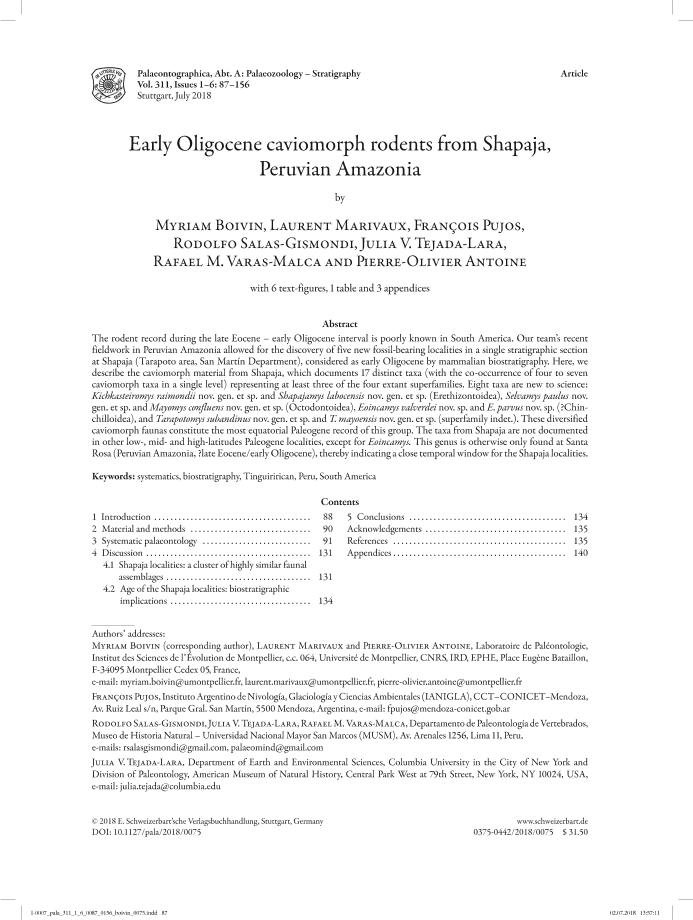Artículo
Early Oligocene caviomorph rodents from Shapaja, Peruvian Amazonia
Boivin, Myriam ; Marivaux, Laurent; Pujos, François Roger Francis
; Marivaux, Laurent; Pujos, François Roger Francis ; Salas Gismondi, Rodolfo; Tejada Lara, Julia V.; Varas Malca, Rafael M.; Antoine, Pierre Olivier
; Salas Gismondi, Rodolfo; Tejada Lara, Julia V.; Varas Malca, Rafael M.; Antoine, Pierre Olivier
 ; Marivaux, Laurent; Pujos, François Roger Francis
; Marivaux, Laurent; Pujos, François Roger Francis ; Salas Gismondi, Rodolfo; Tejada Lara, Julia V.; Varas Malca, Rafael M.; Antoine, Pierre Olivier
; Salas Gismondi, Rodolfo; Tejada Lara, Julia V.; Varas Malca, Rafael M.; Antoine, Pierre Olivier
Fecha de publicación:
07/2018
Editorial:
E Schweizerbartsche Verlags
Revista:
Palaeontographica
ISSN:
0375-0442
Idioma:
Inglés
Tipo de recurso:
Artículo publicado
Clasificación temática:
Resumen
The rodent record during the late Eocene - early Oligocene interval is poorly known in South America. Our team's recent fieldwork in Peruvian Amazonia allowed for the discovery of five new fossil-bearing localities in a single stratigraphic section at Shapaja (Tarapoto area, San Martín Department), considered as early Oligocene by mammalian biostratigraphy. Here, we describe the caviomorph material from Shapaja, which documents 17 distinct taxa (with the co-occurrence of four to seven caviomorph taxa in a single level) representing at least three of the four extant superfamilies. Eight taxa are new to science: Kichkasteiromys raimondii nov. gen. et sp. and Shapajamys labocensis nov. gen. et sp. (Erethizontoidea), Selvamys paulus nov. gen. et sp. and Mayomys confluens nov. gen. et sp. (Octodontoidea), Eoincamys valverdei nov. sp. and E. parvus nov. sp. (?Chinchilloidea), and Tarapotomys subandinus nov. gen. et sp. and T. mayoensis nov. gen. et sp. (superfamily indet.). These diversified caviomorph faunas constitute the most equatorial Paleogene record of this group. The taxa from Shapaja are not documented in other low-, mid- and high-latitudes Paleogene localities, except for Eoincamys. This genus is otherwise only found at Santa Rosa (Peruvian Amazonia, ?late Eocene/early Oligocene), thereby indicating a close temporal window for the Shapaja localities.
Palabras clave:
BIOSTRATIGRAPHY
,
PERU
,
SOUTH AMERICA
,
SYSTEMATICS
,
TINGUIRIRICAN
Archivos asociados
Licencia
Identificadores
Colecciones
Articulos(IANIGLA)
Articulos de INST. ARG. DE NIVOLOGIA, GLACIOLOGIA Y CS. AMBIENT
Articulos de INST. ARG. DE NIVOLOGIA, GLACIOLOGIA Y CS. AMBIENT
Citación
Boivin, Myriam; Marivaux, Laurent; Pujos, François Roger Francis; Salas Gismondi, Rodolfo; Tejada Lara, Julia V.; et al.; Early Oligocene caviomorph rodents from Shapaja, Peruvian Amazonia; E Schweizerbartsche Verlags; Palaeontographica; 311; 1-6; 7-2018; 87-156
Compartir
Altmétricas



